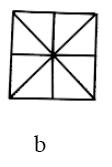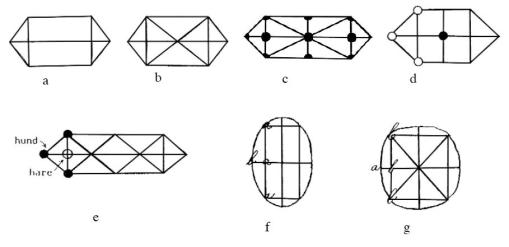One of the talks I will be most disappointed to miss at the upcoming Board Games Studies Colloquium, in Paris from 14 – 17 April, will be that given by Peter Michaelsen entitled “Haretavl – hare and hounds as a board game”
Michaelsen is one of the few writers who have had anything to say about the family of Hare games, including his paper ‘Somme trak også tavl – om et gammelt tidsfordriv og dets navne’ ([untranslatable Danish dialect that beat Google translator] – On an old pastime and its names) in Ord og Sag 18 (1998). The paper dealt with a number of games played in North Jutland (Denmark), including Morris games, Tik Tac Toe, Hare games, Fox and Geese, the unidentified ‘Springtavl’, and draughts.
The text (in Danish) of Michaelsen’s article is freely available on the internet, so I don’t think I would be breaking any copyright rules by posting here my own translation of the section on Hare Games:
—————————————————————————————–
Hare and Hounds or ‘dog after the hare’
Hare and Hounds, another games mentioned in Kvolsgaard[1] can rightly called “the forgotten game”. Neither Willard Fiske nor H.J.R. Murray mentions the game in their monumental works on board games. Murray mentions a variant of the game, played on a draughts board, but he was not aware of the same game on a small board.
The history of the Hare and Hounds game is virtually unknown. In one recent work on the games I’ve found a few details about the game, unfortunately without further sources acknowledged. The work is called Fun and Games in Old Europe[2] and is a translation of a Hungarian work. It mentioned (on p.72) – as a medieval variant of the Morris game – that one can play the so-called Fox Game on the simple Morris board in figure 9 b.
The aim here was to flank the fox on two sides by two hares, and thereby block the sets. If this information is correct, the authors are correct in saying that the game is a transitional form between Morris/Tic Tac Toe games and Hunt games. A little later in the book two game boards for a Fox and Geese game are shown, apparently identical with a Fox and Hen game, which include three hares (elsewhere: three dogs) which chase a fox, and try to squeeze it into a corner.[3]
In a number of Danish sources I have found diagrams and rules which shed some more light on this game.
The various boards in Fig. 10 more or less resemble boards for Tic Tac Toe (from Fig. 9), only extended with a triangle at each end (or possibly. in all four sides), which allows the pursuers to drive the hunted animals into a corner.
The rules are described in the Spillebog for Børn (Gamebook for Children, Copenhagen 1853): “It is played by two children …, one has a piece which depicts the hare, and the other has three pieces depicting dogs. It includes a board, as shown below and which everyone can draw. When the game starts, the hare chooses whatever point it wishes, and then the other player puts his dogs wherever he wants. Then they move alternately, except that of course only one dog can move at a time. When the dog has contained the hare so that it is immobilised, the game is won. When the person who has the hare, however, plays cautiously and cleverly it is very difficult or almost impossible for the dogs to catch the hare“.
Figure 10 a and b are depicted in Èndreis (p.82); b also in J.C.S. Espersen: Bornholmsk Ordbog (Bornholm Dictionary, Copenhagen 1908), s.126, in Fr. Knudsen and H. Lüttichau: Hjemmenes Legebog (Home Thought Playbook, Copenhagen 1921), s.114. Finally, it is known from Birkholm by Drejø. c is depicted in Spillebog for Børn, (Copenhagen 1853), p.35, and is also known from Funen. d is depicted in the Drengenes egen Bog (boys’ own book Copenhagen 1868), p.48, and in P. Waage Jensen: Brik- og brætspil (brick and board games Copenhagen 1977), p.169. e is from Arne Espe Overgaard: Vendsysselsk Ordbog V (Vendsyssel Dictionary V (Supplement) Aarhus 1986), p. 58. f and g are known from Vestfyn (West Funen) from about 1860, g is printed in Fynsk Hjemstavn (Funen Homeland 1937), p.30. The model was apparently the previous variant (f).
The variant from Vendsyssel (the extreme north of Jutland), recorded by Arne Espegaard, has a fixed starting position with the dogs positioned at one end of the figure and hare between two of the dogs; a similar position but with the hare on the centre point of the board, is shown by P. Waage Jensen. This latter also adds the rule that the pursuers must not go backwards, a rule which is also mentioned in the Drengenes egen Bog (Boys’ Own Book). Here the dogs can only go forward, while the hare may go both backwards and forwards. The hare wins if it escapes its pursuers and reaches the opposite end of the board.
The Drengenes egen Bog is a translation of the English ‘Boy’s Own Book’. Thus we have also evidence of the ‘Hare, Pursued by Dogs’ in England. P. Waage Jensen calls the game the Military Game, and says that it is called that “because it was very popular in military circles in France during and after the Franco-German War 1870-71“.
Hare and Hounds is mentioned as early as 1802 in the VSO[4], Vol. 2. The word denotes here “a sort of board game where one player has only one piece, the second player several, with which he must seek to block the single piece.”
In Funen and Zealand the game was called hund efter hare (dog after hare), while the commonest Jutland name was haretavl (hare game). On Bornholm the board game was called: ad träkkja harataula (to play hare game), while the board itself was called haramölla (hare mill). Players usually wrote with chalk on a board or table and used nutshells instead of pieces.
One reference from the area of Horsens (central Jutland) calls the game rævetavl (fox game).
Here the game was played with three dogs and a fox. When the three dogs were in a row, the fox was caught. This example certainly explains why several informants pointed out the word rævetavl when they were asked about radtavl (Morris).
Hare and Hounds was sometimes transferred to the draughts board whereby the number of pursuers was increased from three to four (or five on 10×10 board). Murray refers to this possibility. In Germany the game was known as Wolf and Sheep (Wolf und Schafe), Hare and Hounds (Hase und Hunde) or Foxhunt (Fuchsjagd). Among the English names were Fox and Geese and the Devil among the Tailors.[5]
Anna Erslev described the variant Ulv og Faar (wolves and sheep), in her Illustreret Legebog (Illustrated Gamebook, Copenhagen 1904) p.135. The wolf is on one side edge of board, the sheep in the row on the other side of the board. The wolf may move both forward and back, while the sheep can only go forward. The wolf’s task is to break through the row of sheep, while they in turn seek to block it. Finally, she mentions a variant which I have not found in other sources: “Similarly played ‘Hund efter Hare’ (Dog after the Hare), but for this you would use a Morris diagram. There are 3 dogs, placed on the three lower points and one Hare, who may choose his own place.” Morris diagrams were marked with diagonals, as shown in Figure 2 b.
[1] Videnskabernes Selskabs Ordbog (Scientific Society Dictionary)
[2] Erwin Glonnegger Das Spiele-Buch, Ravensburg 1988, p.151 – see also Carl Brorson’s article “Checkers” in Salmonsens Leksikon: “The dog after the hare” or “The devil among the tailors”.
[3] Èndrei (note 50) p.72 and 81, respectively. p.82-83.
[4] In his book Scattered incidents of rural life (Spredte Træk af Landbolivet), recorded in the Jutland dialect, Copenhagen 1891, CMC Kvolsgaard, associate professor at Ranum College, describes life as it was in the North Hanherred approximately 30 years earlier.
[5] Walter Èndrei, Fun and Games in Old Europe. edn. by Werner Dausien, Hanau 1988



